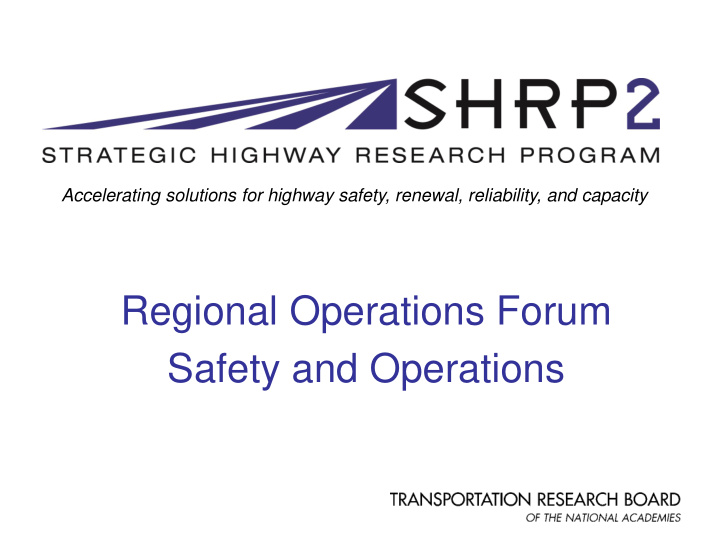



Accelerating solutions for highway safety, renewal, reliability, and capacity Regional Operations Forum Safety and Operations
Linking Safety and Operations • State DOTs facing numerous challenges • Prior to ISTEA, DOTs focused separately on – Construction – Maintenance – Operations – Safety • Limited resources has shifted focus – Operating and maintaining system 2
Why Link Safety and Operations? • Highway fatalities and serious injuries at unacceptable levels • 29,757 fatalities in 2011 – Press coverage not significant for highway fatalities – Boeing 747-400 carries 520 passengers – 2011 highway fatalities = 56 airline crashes 3
U.S. Fatal Crash Trends Source: NHTSA FARS Data 4
VMT Trends Source: NHTSA FARS Data 5
Fatal Crash Rate Trends Source: NHTSA FARS Data 6
U.S. Injury Crash Trends 7
Injury Crash Rate Trends 8
Traffic Congestion • Congestion continues to plague our transportation system – 2.9 billion gallons of wasted fuel • Enough to fill 4 superdomes – 5.5 billion hours of wasted time • Significantly impacts communities – Quality of life – Safety – Health 9
Types of Traffic Congestion • Recurring congestion – Predictable in cause • Location • Time of day • Duration – Surge overwhelms roadway’s capacity – Examples • Lane drops, grades, narrow lanes • Poorly timed traffic signals 10
Types of Traffic Congestion • Non-recurring congestion – Unpredictable in nature • Location • Time of day • Duration – Examples • Crashes, disabled vehicles, weather • Work zones and planned special events • Dramatically reduces capacity and reliability 11
MAP-21 Requirements • Creates national goals and performance management measures – Safety – Congestion reduction – System reliability • Performance targets currently being developed 12
Safety and Throughput • Low cost operational improvements can create significant improvements in traffic flow – Equate to having safer roads • Low cost operational improvements – Signal phasing (permissive vs. protected) – Signal timings and progression – Appropriate clearance intervals – Pavement markings, signing, and delineation – Installation or extension of turn lane 13
Opportunities to Affect Safety and Operations DETERMINING WHERE SAFETY AND OPERATIONS ARE MOST EFFECTIVE 14
Static Data 15
Real Time Data Acquisition 16
Real Time Data Acquisition 17
Real Time Data Acquisition 18
Real Time Data Acquisition 19
Roadway Weather Information 20
Opportunities to Affect Safety and Operations ANALYSIS TECHNIQUES 21
Crash Locations Through GIS 22
Intersection Crash Analysis 23
Crash Density Maps 24
Peak Hour Travel Time Index 25
Crash Density with AM Peak Travel Time Index 26
Project Examples 27
Median/Pedestrian Refuge 28
Road Diets 29
Access Management 30
Turn Lanes 31
Signal Timing and Improvements 32
Ramp Metering 33
Variable Speed Limits 34
Adaptive Signal Timing 35
Advanced Traveler Information Systems 36
Incident Management 37
End of Queue Detection Systems 38
Advanced Traffic Management 39
SHRP 2 Project L07 40
Group Discussion 41
Recommend
More recommend